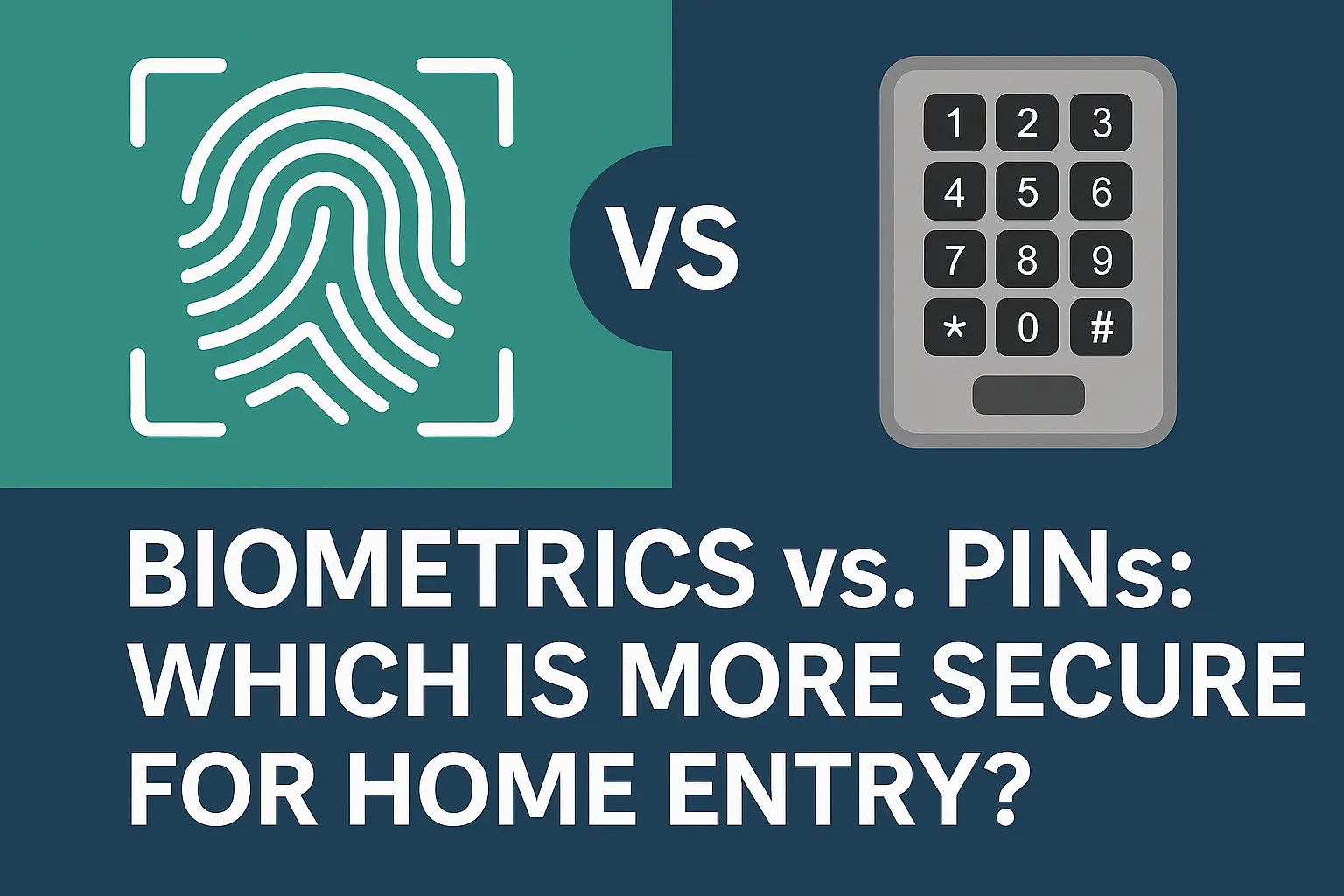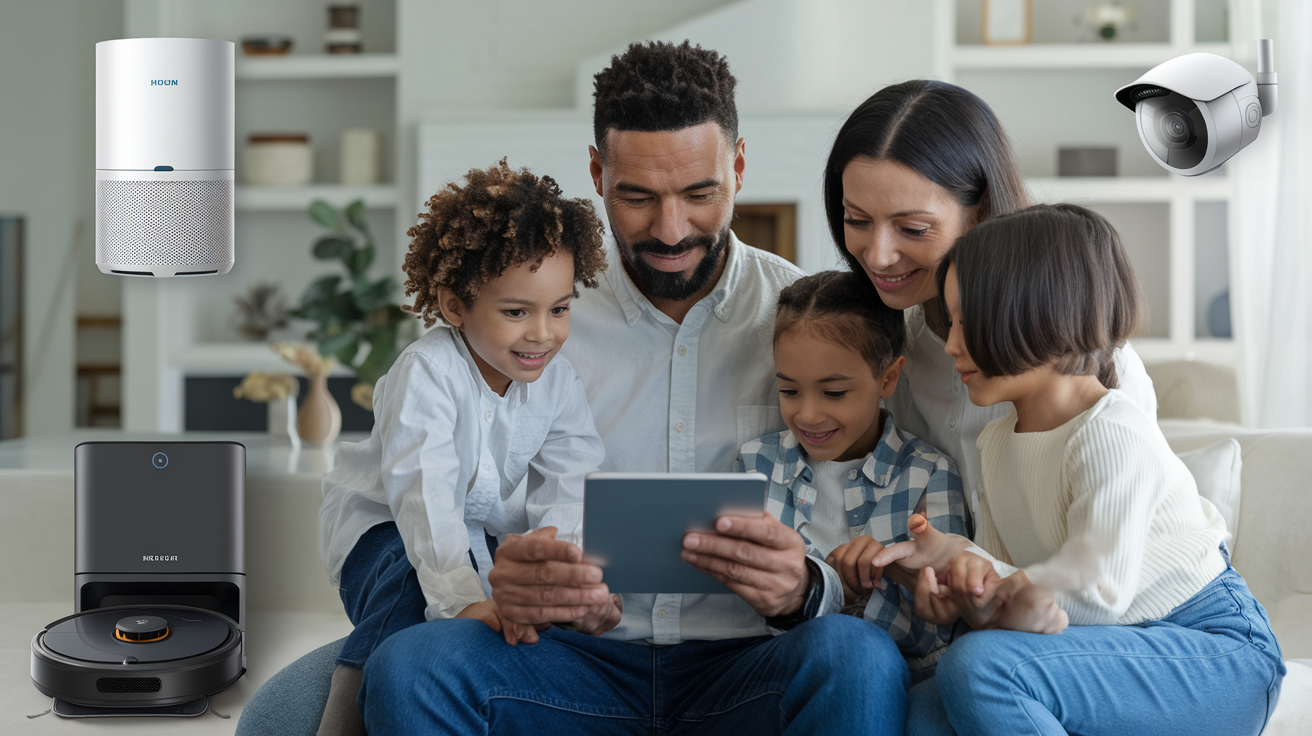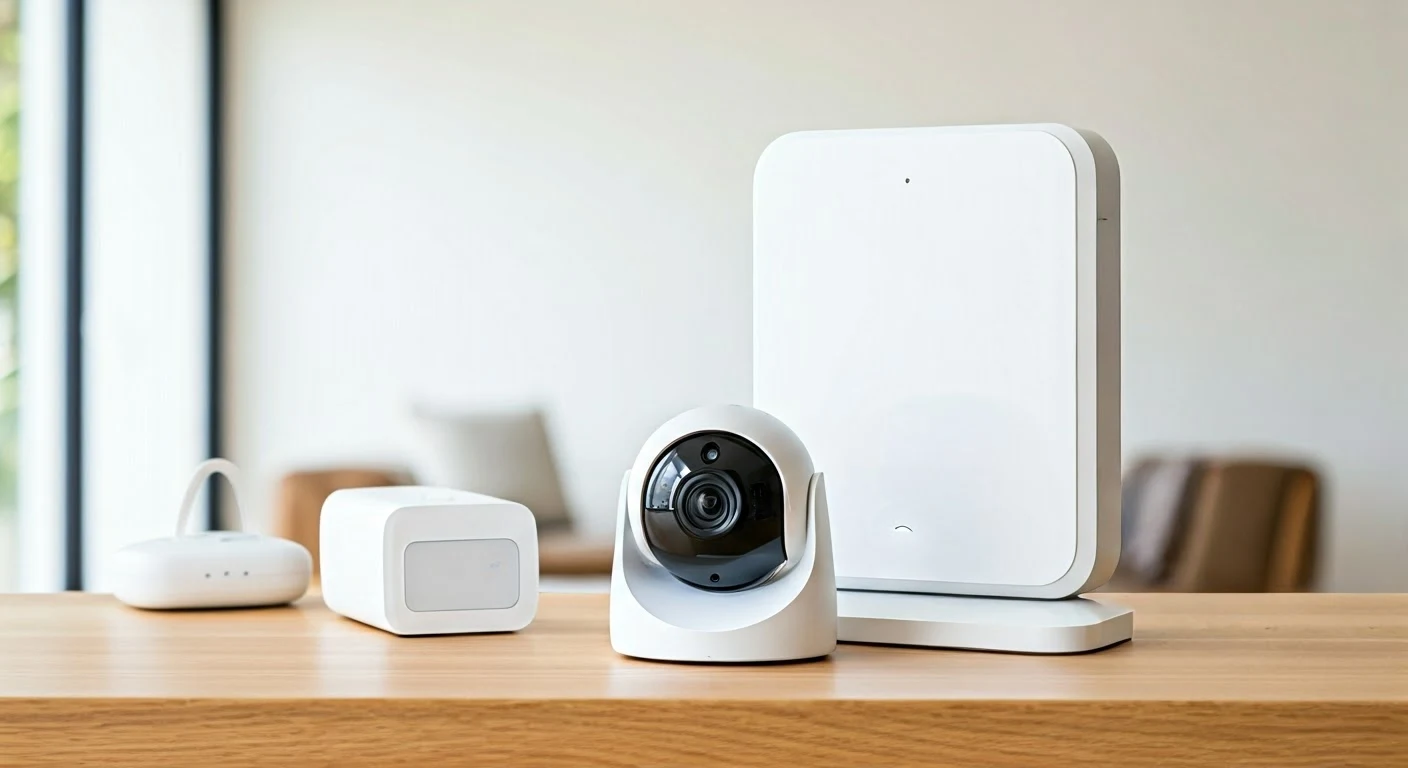In 2025, home security has evolved far beyond traditional keys, with smart locks incorporating advanced technologies like biometrics and PIN-based keypads. As homeowners prioritize safety and convenience, the debate over whether biometrics (e.g., fingerprint or facial recognition) or PINs (numeric codes entered on a keypad) offer better security for home entry has intensified. Both systems have unique strengths and vulnerabilities, and choosing the right one depends on balancing security, usability, and cost. This comprehensive guide explores how biometrics and PINs work, their security features, real-world applications, and which might be the best fit for your home in 2025.
Understanding Biometrics
What Are Biometrics?
Biometrics refers to authentication methods that use unique physical or behavioral characteristics to verify identity. For home entry, the most common biometric technologies include:
-
Fingerprint Scanning: Analyzes the unique patterns of ridges and valleys on a person’s fingertips.
-
Facial Recognition: Uses facial features, such as the distance between eyes or nose shape, for identification.
-
Iris Scanning: Examines the intricate patterns in the iris of the eye.
-
Voice Recognition: Authenticates based on vocal patterns and characteristics.
These technologies are integrated into smart locks, such as the Lockly Visage Zeno Series, which uses facial recognition, or the Ultraloq Bolt Fingerprint, which relies on fingerprint scanning.
How Biometrics Work for Home Entry
Biometric systems operate in three stages:
-
Enrollment: The system captures and stores a digital template of the user’s biometric trait (e.g., a fingerprint or facial scan).
-
Authentication: When access is requested, the system scans the presented biometric data and compares it to the stored template.
-
Verification: If the data matches, the lock opens; if not, access is denied, and some systems trigger a security alert.
For example, the Philips Home Access 5000 Series, showcased at CES 2025, uses palm vein recognition combined with HD video monitoring for secure and seamless entry.
Advantages of Biometrics
-
Uniqueness: Biometric traits are unique to each individual, making unauthorized replication difficult.
-
Convenience: No need to carry keys or memorize codes; your body is the key.
-
Speed: Biometric authentication is often faster than entering a PIN, with systems like the Lockly Visage Zeno Series unlocking “nearly instantly” even in challenging conditions like direct sunlight (WIRED, 2025).
-
Integration: Biometric locks integrate with smart home systems, enabling features like remote access logs and real-time notifications.
Disadvantages of Biometrics
-
Privacy Concerns: Storing biometric data raises questions about data security and potential misuse. If a database is breached, sensitive information could be exposed.
-
Spoofing Risks: Though rare, biometric systems can be fooled by advanced techniques, such as using high-quality fake fingerprints or 3D-printed facial models.
-
Inability to Change: Unlike PINs, biometric traits like fingerprints or faces cannot be changed if compromised.
-
Cost: Biometric locks, like the Eufy Security S230, are often more expensive than PIN-based systems.
Understanding PINs
What Are PINs?
A Personal Identification Number (PIN) is a numeric code, typically 4 to 8 digits, used to authenticate a user. In home entry systems, PINs are entered via a keypad on a smart lock, such as the Yale Assure Lock 2 Touch Smart Lock.
How PINs Work for Home Entry
Users input their PIN on a keypad, and the system compares it to the stored code. If it matches, the lock opens. Many smart locks, like the Schlage Encode Smart WiFi Deadbolt, allow multiple PINs for different users, with features like temporary codes for guests.
Advantages of PINs
-
Ease of Use: PINs are simple to enter and remember, especially for short codes.
-
Changeability: If a PIN is compromised, it can be easily changed via the lock’s app or interface.
-
Cost-Effective: PIN-based keypads are generally less expensive than biometric systems, making them accessible for budget-conscious homeowners.
-
Flexibility: PINs can be shared with family, friends, or service providers and revoked as needed.
Disadvantages of PINs
-
Shoulder Surfing: PINs can be observed by others when entered, a vulnerability known as shoulder surfing.
-
Brute-Force Attacks: Short PINs (e.g., 4 digits) have limited combinations (10,000 for a 4-digit PIN), making them susceptible to guessing, though modern systems often lock out after failed attempts.
-
User Error: Weak PINs (e.g., “1234” or birthdates) are common and easily guessed. Users may also forget their PINs, leading to lockouts.
Security Comparison
To determine which is more secure for home entry, let’s compare biometrics and PINs across key security metrics:
| Metric | Biometrics | PINs |
|---|---|---|
| Uniqueness | Highly unique; tied to individual traits, making replication difficult. | Limited by digit combinations; weak PINs (e.g., “1234”) are easily guessed. |
| Vulnerability to Theft | Rare but possible via spoofing (e.g., fake fingerprints). | Susceptible to shoulder surfing or keylogging. |
| Changeability | Cannot be changed if compromised. | Easily changed if compromised. |
| Ease of Attack | Requires advanced techniques and materials to spoof. | Can be guessed or observed with minimal effort if not secured properly. |
| System Dependency | Relies on secure storage of biometric templates and anti-spoofing technology. | Relies on encryption and lockout mechanisms to prevent brute-force attacks. |
Resistance to Attacks
Biometrics are generally more resistant to attacks because they rely on unique physical traits. For instance, the Lockly Visage Zeno Series uses advanced facial recognition that works even with sunglasses, reducing false positives (WIRED, 2025). However, spoofing remains a concern, though it requires specialized knowledge and tools, such as 3D-printed masks or high-resolution fingerprint replicas.
PINs, conversely, are vulnerable to simpler attacks. Shoulder surfing can compromise a PIN in seconds, and weak PINs are easily guessed. For example, a 4-digit PIN has only 10,000 possible combinations, equivalent to about 13.3 bits of entropy, making it less secure than a complex password (nextAuth, 2023). Modern smart locks mitigate this with features like temporary lockouts after failed attempts, but the risk persists.
User Behavior
User behavior significantly impacts security. Many users choose predictable PINs, such as “1234” or birthdates, which are among the most common and easily compromised (Security Boulevard, 2025). Biometrics eliminate this issue, as they don’t rely on user-chosen codes. However, users must ensure biometric systems are enrolled correctly to avoid false negatives (e.g., a fingerprint scanner failing due to dirty hands).
System Integrity
The security of both systems depends on the underlying technology. Biometric systems require secure storage of templates (not raw biometric data) to prevent breaches. For example, the Eufy Security S230 stores encrypted fingerprint templates locally, reducing hacking risks (CNET, 2025). PIN systems rely on encryption and features like lockout timers to prevent brute-force attacks. A poorly designed system, whether biometric or PIN-based, can be a weak link.
Real-World Examples
-
Biometric Breaches: Historical cases, like using gummy bear fingerprints to fool early fingerprint scanners, highlight spoofing risks, though modern systems with anti-spoofing technology (e.g., liveness detection) are far more robust.
-
PIN Breaches: PINs are frequently compromised through observation or weak choices. For instance, a 2025 study noted that users often reuse PINs across devices, increasing vulnerability if one system is breached (Security Boulevard, 2025).
Integration with Smart Home Systems
Both biometrics and PINs are seamlessly integrated into 2025’s smart home ecosystems, enhancing functionality and user experience.
Smart Locks
Smart locks like the Yale Assure Lock 2 Touch combine biometric and PIN options, offering flexibility. Users can unlock via fingerprint, PIN, or smartphone app, with integration into platforms like Alexa, Google Home, or Apple HomeKit (CNN Underscored, 2025). The Schlage Encode Smart WiFi Deadbolt, praised for its reliability, supports PINs and app-based control, with optional biometric add-ons (Wirecutter, 2025).
Access Control and Monitoring
Biometric locks often include advanced features like access logs and real-time notifications, which integrate with smart home systems. For example, the Philips Home Access 5000 Series offers HD video monitoring alongside palm vein recognition, allowing homeowners to track who enters and when (ID Tech, 2025). PIN-based systems also offer audit trails, but their simplicity makes them less feature-rich compared to biometric counterparts.
Multi-Factor Authentication
Many 2025 smart locks support multi-factor authentication (MFA), combining biometrics and PINs for enhanced security. For instance, the Ultraloq Bolt Fingerprint requires a fingerprint and a PIN for high-security settings, reducing the risk of unauthorized access (PCMag, 2025).
Future Trends in Home Entry Security
The home security landscape in 2025 is rapidly evolving, driven by advancements in technology:
-
Multimodal Biometrics: Systems combining multiple biometric traits (e.g., fingerprint and facial recognition) are becoming standard for high-security applications, offering greater accuracy and resistance to spoofing (HyperVerge, 2024).
-
AI and Machine Learning: AI enhances biometric systems by improving liveness detection and adapting to changes in biometric traits (e.g., aging faces). AI-powered cameras, like those in the Eufy Security S230, can differentiate between people and objects, reducing false alarms (CNET, 2025).
-
Enhanced PIN Security: Longer PINs (e.g., 8 digits) and MFA are becoming more common to counter brute-force attacks. Some systems now require a PIN alongside a smartphone app verification.
-
Smart Home Integration: Biometric and PIN-based locks are increasingly compatible with smart home ecosystems, enabling features like voice control and automated routines (e.g., unlocking when you arrive home) (Guardian Protection, 2025).
Which is More Secure?
Biometrics generally offer superior security for home entry due to their uniqueness and resistance to common attacks like shoulder surfing or guessing. A 2025 report from Guardian Protection notes that biometric systems, such as those using facial recognition or fingerprint scanning, are “nearly impossible to replicate,” deterring unauthorized entry (Guardian Protection, 2025). However, their security hinges on robust anti-spoofing measures and secure data storage.
PINs, while simpler and more cost-effective, are more vulnerable to human error and observation. A 4-digit PIN has only 10,000 possible combinations, making it less secure than a biometric trait, though modern systems mitigate this with lockout features and encryption (nextAuth, 2023).
That said, no system is infallible. Biometrics can be compromised by advanced spoofing, and PINs can be stolen through observation. Combining both—using a biometric primary authentication with a PIN as a backup—offers a robust solution, as seen in locks like the Ultraloq Bolt Fingerprint.
Choosing the Right System for Your Home
When deciding between biometrics and PINs, consider the following:
-
Security Needs: If maximum security is your priority, biometrics are the better choice due to their uniqueness. For moderate security needs, a PIN-based system with strong encryption and lockout features may suffice.
-
Budget: PIN-based locks are generally more affordable, with models like the Yale Approach Lock starting at around $130, while biometric locks like the Lockly Visage Zeno Series can cost $300 or more (CNN Underscored, 2025).
-
Convenience: Biometrics offer a seamless, keyless experience, ideal for busy households. PINs are simpler but require memorization.
-
Privacy Concerns: If you’re wary of storing biometric data, a PIN-based system might be preferable, provided you choose a strong, unique code.
Recommended Smart Locks for 2025
Here are some top smart locks that incorporate biometrics and/or PINs, based on 2025 reviews:
| Smart Lock | Features | Price (Approx.) | Source |
|---|---|---|---|
| Lockly Visage Zeno Series | Facial recognition, PIN keypad, app control, works in sunlight/sunglasses | $429 | WIRED, 2025 |
| Ultraloq Bolt Fingerprint | Fingerprint scanning, PIN keypad, app control, HomeKit compatibility | $200 | PCMag, 2025 |
| Yale Assure Lock 2 Touch | Fingerprint scanning, PIN keypad, Bluetooth, modular design | $200 | CNN Underscored, 2025 |
| Philips Home Access 5000 Series | Palm vein recognition, HD video monitoring, Matter compatibility | TBD (2025 release) | ID Tech, 2025 |
| Schlage Encode Smart WiFi | PIN keypad, app control, WiFi, optional biometric add-ons | $250 | Wirecutter, 2025 |
FAQs
1. Is biometric security more secure than PINs for home entry?
Biometrics are generally more secure because they rely on unique physical traits that are hard to replicate. However, their security depends on robust anti-spoofing measures and secure data storage. PINs are less secure due to risks like shoulder surfing but can be effective with strong codes and lockout features.
2. Can biometric data be stolen?
While stealing biometric data is challenging, it’s possible if a system’s database is breached. Most modern systems store encrypted templates rather than raw data, reducing this risk. Choose locks from reputable brands with strong encryption.
3. What happens if I forget my PIN?
Most smart locks offer alternative access methods, such as a master key, smartphone app, or emergency code, to regain access and reset the PIN.
4. Are there privacy concerns with biometric home entry systems?
Yes, storing biometric data raises privacy concerns. Opt for systems that store data locally (not in the cloud) and use encryption to protect it, like the Eufy Security S230.
5. Can I use both biometrics and PINs for added security?
Yes, many smart locks, like the Ultraloq Bolt Fingerprint, support multi-factor authentication, allowing you to use both biometrics and PINs for enhanced security.
6. How do I choose between biometrics and PINs?
Consider your security needs, budget, and comfort with technology. Biometrics are ideal for high security and convenience, while PINs are better for simplicity and affordability. Combining both offers the best of both worlds.
Conclusion
In 2025, biometrics generally provide a higher level of security for home entry due to their unique nature and resistance to common attacks like shoulder surfing or brute-force guessing. However, PINs remain a viable, cost-effective option, especially when paired with strong encryption and lockout mechanisms. The best approach may be a hybrid system, like the Yale Assure Lock 2 Touch, which combines biometrics and PINs for flexibility and robust security. As smart home technology advances, integrating these systems with AI and smart home ecosystems will further enhance their effectiveness. Choose a system that aligns with your security needs, budget, and privacy preferences to keep your home safe and secure.






